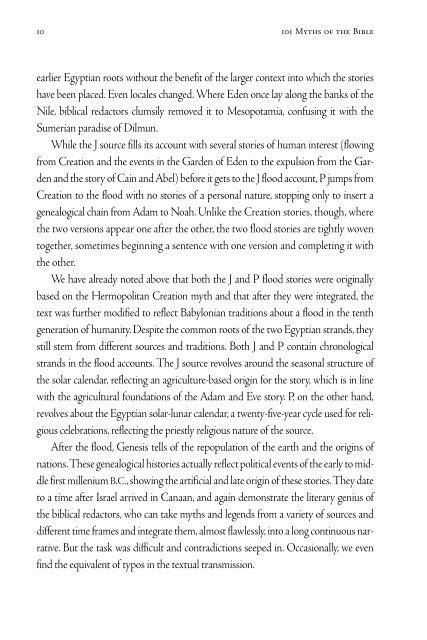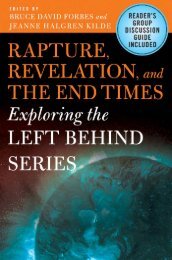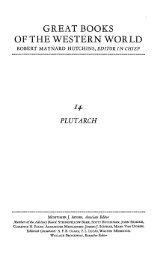- Page 1 and 2: yths of the Bible ow ncient cribes
- Page 3 and 4: Copyright © 2000 by Gary Greenberg
- Page 6 and 7: Contents Preface . . . . . . . . .
- Page 8 and 9: Table of Contents vii 48. Abraham c
- Page 10 and 11: Preface n 101 Myths of the Bible, I
- Page 12 and 13: Preface xi Moses, according to the
- Page 14: Preface xiii breakup of Solomon’s
- Page 17 and 18: xvi 101 Myths of the Bible Over the
- Page 19 and 20: xviii 101 Myths of the Bible J may
- Page 21 and 22: xx 101 Myths of the Bible and polit
- Page 23 and 24: xxii 101 Myths of the Bible the bib
- Page 25 and 26: xxiv 101 Myths of the Bible period?
- Page 27 and 28: xxvi 101 Myths of the Bible The pre
- Page 30 and 31: Timetable of Biblical History (All
- Page 32: P a r t O n e yths of the Beginning
- Page 35 and 36: 4 101 Myths of the Bible ditions, w
- Page 37 and 38: 6 101 Myths of the Bible and how it
- Page 39: 8 101 Myths of the Bible Adam and E
- Page 43 and 44: 12 101 Myths of the Bible 2. darkne
- Page 45 and 46: 14 yth #3: Creation began with the
- Page 47 and 48: 16 101 Myths of the Bible but it wa
- Page 49 and 50: 18 yth #6: God called the firmament
- Page 51 and 52: 20 101 Myths of the Bible mounds of
- Page 53 and 54: 22 yth #9: God created the heavenly
- Page 55 and 56: 24 yth #10: Birds emerged from the
- Page 57 and 58: 26 101 Myths of the Bible scholars
- Page 59 and 60: 28 yth #12: God created Adam and Ev
- Page 61 and 62: 30 101 Myths of the Bible While thi
- Page 63 and 64: 32 yth #13: God gave man dominion o
- Page 65 and 66: 34 yth #14: God created earth on th
- Page 67 and 68: 36 101 Myths of the Bible carried t
- Page 69 and 70: 38 101 Myths of the Bible Sabbath,
- Page 71 and 72: 40 101 Myths of the Bible ers of th
- Page 73 and 74: 42 101 Myths of the Bible As the re
- Page 75 and 76: 44 101 Myths of the Bible give birt
- Page 77 and 78: 46 yth #19: God formed Adam from th
- Page 79 and 80: 48 yth #20: God planted a Tree of L
- Page 81 and 82: 50 101 Myths of the Bible and each
- Page 83 and 84: 52 101 Myths of the Bible between t
- Page 85 and 86: 54 yth #23: Eve came from Adam’s
- Page 87 and 88: 56 yth #24: Adam gained wisdom with
- Page 89 and 90: 58 yth #25: There were other beings
- Page 91 and 92:
60 101 Myths of the Bible The secon
- Page 93 and 94:
62 yth #27: Adam and Eve lived a si
- Page 95 and 96:
64 yth #28: The serpent was more su
- Page 97 and 98:
66 yth #29: God punished Adam, Eve,
- Page 99 and 100:
68 yth #30: Cain killed Abel. The M
- Page 101 and 102:
70 101 Myths of the Bible return to
- Page 103 and 104:
72 101 Myths of the Bible Enoch, bu
- Page 105 and 106:
74 101 Myths of the Bible of vowels
- Page 107 and 108:
76 yth #33: Ham was the father of C
- Page 109 and 110:
78 yth #34: Noah released birds to
- Page 111 and 112:
80 101 Myths of the Bible The bibli
- Page 113 and 114:
82 101 Myths of the Bible ity. So,
- Page 115 and 116:
84 yth #36: All earthly life had be
- Page 117 and 118:
86 101 Myths of the Bible Because t
- Page 119 and 120:
88 101 Myths of the Bible sition cl
- Page 121 and 122:
90 yth #39: The rain lasted forty d
- Page 123 and 124:
92 yth #40: The flood covered the e
- Page 125 and 126:
94 yth #42: All living creatures no
- Page 127 and 128:
96 101 Myths of the Bible for examp
- Page 129 and 130:
98 101 Myths of the Bible moved the
- Page 131 and 132:
100 101 Myths of the Bible used wit
- Page 133 and 134:
102 101 Myths of the Bible clearly
- Page 135 and 136:
104 101 Myths of the Bible Libya, a
- Page 138 and 139:
yths of the Founders AN OVERVIEW he
- Page 140 and 141:
Myths of the Founders 109 and siste
- Page 142 and 143:
Myths of the Founders 111 Joseph ha
- Page 144 and 145:
Myths of the Founders 113 In the fi
- Page 146 and 147:
yth #48: Abraham came from Ur of th
- Page 148 and 149:
yth #49: Abraham left Egypt to go t
- Page 150 and 151:
Myths of the Founders 119 But, no s
- Page 152 and 153:
Myths of the Founders 121 Genesis c
- Page 154 and 155:
Myths of the Founders 123 said, My
- Page 156 and 157:
Myths of the Founders 125 handful o
- Page 158 and 159:
yth #51: Lot’s wife turned into a
- Page 160 and 161:
yth #52: Lot fathered Ammon and Moa
- Page 162 and 163:
yth #53: Abraham pretended that Sar
- Page 164 and 165:
Myths of the Founders 133 tell thee
- Page 166 and 167:
yth #54: Jacob and Esau fought in t
- Page 168 and 169:
Myths of the Founders 137 Plutarch
- Page 170 and 171:
Myths of the Founders 139 Genesis t
- Page 172 and 173:
Myths of the Founders 141 to one of
- Page 174 and 175:
Myths of the Founders 143 give all
- Page 176 and 177:
yth #57: Jacob wrestled with a stra
- Page 178 and 179:
Myths of the Founders 147 In additi
- Page 180 and 181:
Myths of the Founders 149 major cul
- Page 182 and 183:
yth #60: Jacob buried Rachel in Bet
- Page 184 and 185:
Myths of the Founders 153 The Egypt
- Page 186 and 187:
Myths of the Founders 155 The main
- Page 188 and 189:
Myths of the Founders 157 In the E
- Page 190 and 191:
Myths of the Founders 159 You would
- Page 192 and 193:
Myths of the Founders 161 Naphtali
- Page 194 and 195:
Myths of the Founders 163 As Jacob
- Page 196 and 197:
Myths of the Founders 165 descripti
- Page 198 and 199:
yth #66: Jacob awarded the sceptre
- Page 200 and 201:
yth #67: Benjamin was born in Canaa
- Page 202 and 203:
yth #68: Dan was an Israelite tribe
- Page 204 and 205:
yth #69: Jacob gave Joseph a coat o
- Page 206 and 207:
yth #70: Joseph’s brothers sold h
- Page 208 and 209:
Myths of the Founders 177 This port
- Page 210 and 211:
Myths of the Founders 179 The Herod
- Page 212 and 213:
Myths of the Founders 181 After Jos
- Page 214:
Myths of the Founders 183 dead had
- Page 218 and 219:
yths of the Heroes AN OVERVIEW omet
- Page 220 and 221:
Myths of the Heroes 189 course of t
- Page 222 and 223:
Myths of the Heroes 191 Solomon imp
- Page 224 and 225:
yth #72: Egypt enslaved Israel for
- Page 226 and 227:
Myths of the Heroes 195 Despite the
- Page 228 and 229:
Myths of the Heroes 197 Reducing Go
- Page 230 and 231:
yth #73: Jochebed placed the infant
- Page 232 and 233:
Myths of the Heroes 201 These two E
- Page 234 and 235:
Myths of the Heroes 203 of the prec
- Page 236 and 237:
yth #75: God sent ten plagues again
- Page 238 and 239:
Myths of the Heroes 207 Bible: And
- Page 240 and 241:
Myths of the Heroes 209 that the Is
- Page 242 and 243:
Myths of the Heroes 211 fallen ones
- Page 244 and 245:
Myths of the Heroes 213 bols to cha
- Page 246 and 247:
yth #78: Moses gave Israel the Ten
- Page 248 and 249:
Myths of the Heroes 217 The Book of
- Page 250 and 251:
Myths of the Heroes 219 dus 24:1, w
- Page 252 and 253:
Myths of the Heroes 221 are the Ten
- Page 254 and 255:
Myths of the Heroes 223 widespread
- Page 256 and 257:
Myths of the Heroes 225 But for his
- Page 258 and 259:
Myths of the Heroes 227 placed it i
- Page 260 and 261:
Myths of the Heroes 229 of statue.
- Page 262 and 263:
Myths of the Heroes 231 That Josiah
- Page 264 and 265:
yth #81: God denied Moses entry int
- Page 266 and 267:
Myths of the Heroes 235 And I besou
- Page 268 and 269:
yth #82: Joshua parted the Jordan.
- Page 270 and 271:
yth #83: Joshua tumbled the walls o
- Page 272 and 273:
yth #84: Rahab aided the Israelite
- Page 274 and 275:
yth #85: Joshua ruined Ai. The Myth
- Page 276 and 277:
yth #86: The sun stood still upon G
- Page 278 and 279:
Myths of the Heroes 247 the sun was
- Page 280 and 281:
Myths of the Heroes 249 Judah, nor
- Page 282 and 283:
Myths of the Heroes 251 after the t
- Page 284 and 285:
Myths of the Heroes 253 the archaeo
- Page 286 and 287:
Myths of the Heroes 255 ents wouldn
- Page 288 and 289:
Myths of the Heroes 257 Israel enjo
- Page 290 and 291:
Myths of the Heroes 259 Tabor locat
- Page 292 and 293:
Myths of the Heroes 261 parent. In
- Page 294 and 295:
yth #93: Samson judged Israel for t
- Page 296 and 297:
Myths of the Heroes 265 Because of
- Page 298 and 299:
Myths of the Heroes 267 The identit
- Page 300 and 301:
yth #94: Samson pulled down a Phili
- Page 302 and 303:
yth #95: Micah stole silver from hi
- Page 304 and 305:
Myths of the Heroes 273 named Ahija
- Page 306 and 307:
Myths of the Heroes 275 These passa
- Page 308 and 309:
Myths of the Heroes 277 The story o
- Page 310 and 311:
Myths of the Heroes 279 Since the B
- Page 312 and 313:
Myths of the Heroes 281 spear as en
- Page 314 and 315:
Myths of the Heroes 283 The present
- Page 316 and 317:
yth #99: Solomon did not impose for
- Page 318 and 319:
yth #100: Daniel predicted the futu
- Page 320 and 321:
Myths of the Heroes 289 Daniel appe
- Page 322 and 323:
Myths of the Heroes 291 Elamites. P
- Page 324:
Myths of the Heroes 293 Agagite’s
- Page 327 and 328:
296 101 Myths of the Bible The proc
- Page 329 and 330:
298 101 Myths of the Bible millenni
- Page 332 and 333:
Suggested Reading The suggested ref
- Page 334 and 335:
Suggested Reading 303 The only subs
- Page 336 and 337:
Table of Maps World of the Patriarc
- Page 338 and 339:
Table of Maps 307 Distribution of t
- Page 340 and 341:
1 Chronicles, Book of, xxii 1 Kings
- Page 342 and 343:
Index 311 Chaeremon, 200 cherubim,
- Page 344 and 345:
Index 313 and Eve, 58; lifestyle in
- Page 346 and 347:
Index 315 Potipher's wife, 180-83;
- Page 348 and 349:
Index 317 Osiris, 4, 9, 21, 23, 44,
- Page 350:
Index 319 Ten Commandments, The, 20
- Page 354:
In his startling book, Gary Greenbe





